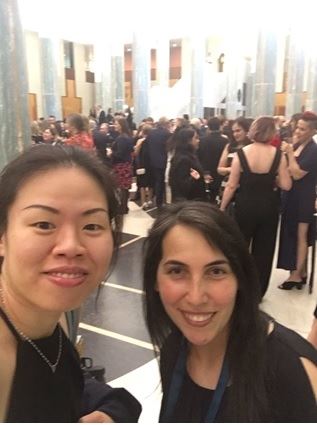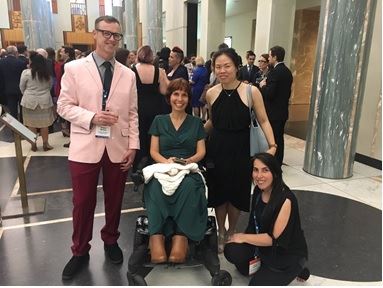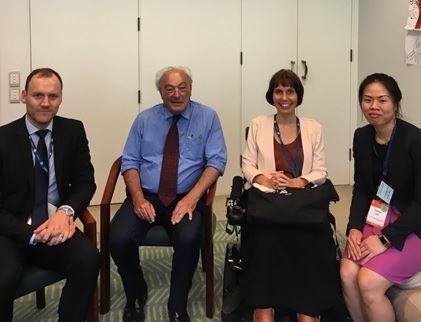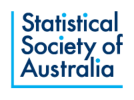Science Meets Parliament (SmP19) – a conference run by Science & Technology Australia - has been bringing scientists and parliamentarians together since 1999. The objectives of the forum are to inform members of parliament how science can contribute to public policy, and provide insight for scientists to the political, media and parliamentary processes that govern the Commonwealth of Australia. Around 200 scientists and communicators were selected to attend this event to discuss the current and future role of science in politics. The Statistical Society of Australia (SSA) selected Carmen Lim from the University of Queensland and Janan Arslan from the University of Melbourne to represent the society at SmP19.
The two-day event (26-27th November) was held at both Hotel Realm and Parliament House in Canberra. The first day of the conference was packed full of presentations and workshops (particularly for first-time attendees), with captivating speakers, such as Professor Fiona Wood AM (Director of Burns Service of WA & 2005 Australian of the Year) and Dr Alan Finkel AO (Australia’s Chief Scientist) taking to the podium. Day One was also a great opportunity for the 200 attendees to connect with each other, which lead to exhilarating conversations. The day ended with a Gala Dinner, which was MC’ed by SCOPE TV presenter Lee Constable. Presentations were given by The Hon Karen Andrews MP (Minister for Industry, Science, and Technology), The Hon Brendan O’Connor MP (Shadow Minister for Employment and Industry, Science, Small and Family Business), and Marina Sara (Chemical Engineer, ANSTO), who shocked our delegates by revealing we work approximately 80,000 hours in our careers. Each table at the dinner contained several scientists as well as a parliamentarian. This was our first opportunity to connect and communicate with policymakers.

L to R:
Carmen Lim and Janan Arslan enjoying a night out at SmP Gala Dinner.

L to R:
Adrian Barnett, Susanna Cramb, Carmen Lim and Janan Arslan. Statisticians storm parliament house!
The second and final day was all about meeting our assigned parliamentarians. Every scientist was assigned to a parliamentarian based on either common scientific interests or by the electorate. Carmen was paired with Dr Mike Freelander MP while Janan was paired with Dr Adam Bandt MP. Janan also attended the National Press Club Address presented by Professor Lisa Harvey-Smith – an award-winning astrophysicist and the Australian Government’s Women in STEM Ambassador - in which she discussed current gender biases and committing to bringing equity in science, engineering, and mathematics. Additional tours were made available for delegates, such as the Parliament House Geology and Beekeeping Tours. The day concluded with a parliamentary panel and discussion that, unfortunately, was short-lived when the bells began to ring throughout Parliament House. The conference was a revelation. It emphasised the importance of scientific communication, highlighted Parliamentary processes, and offered an opportunity to build strong working relationships between scientists and members of parliaments.

L to R:
[First person - Unknown], Dr Mike Freelander, Susanna Cramb, and Carmen. Carmen and fellow scientists meeting Dr Freelander to discuss their respective scientific projects.

L to R:
Tracey Ellis, Peter Baines, Dr Adam Bandt, Janan Arslan, and Amy Winship. Lots of smiles after talking about our work with Dr Adam Bandt.
We want to thank the SSA for supporting our attendance at SmP19. We thank the ever so amazing Marie-Louise Rankin and Adrian Barnett for supporting us throughout the process and guiding us during the conference. This has truly been a remarkable experience. With meeting people across all the STEM careers and parliamentarians privately in small groups, we not only had the opportunity to share our research projects with prominent members of the community but also heard the scientific journey of many others. We connected with fellow scientists and felt completely at home during the entire event. We were reminded of the core values of being a scientist: to seek the truth and make a difference in the world. The most valuable lesson that we learnt was scientists and politicians are actually driven by common goals: we all want to make a difference. We conclude this article with some of Janan’s and Carmen’s highlights and remarkable quotes from the event.
Quotes:
“You could be the best visionary in the world, but if you’re in a soundproof room, what is the point?” – Professor Fiona Wood
“Collaborating with mathematicians and statisticians helps to shape our work.”– STEM Professionals in other fields
“We do not need to fix women. We need to fix the system.” – Professor Lisa Harvey-Smith
“We have to show the politicians where our impact is.” – Dr Alan Finkel
Carmen’s highlight:
My highlight was perhaps learning how to pitch my work in a minute. We fill in existing gaps in scientific knowledge by creating solutions and that has helped me to focus my pitch when speaking with the parliamentary leaders I met in Canberra. I met Dr Mike Freelander, a paediatrician turned MP for the Labour party. I was given an opportunity to discuss the issues around my research on substance abuse in vaping and got a chance to hear his political viewpoints on this. His vision to serve his electorate was truly inspiring. I encourage all scientists to get in touch with their local MP and see how your research can be translated into impactful research. Politicians are apparently good storytellers. SSA members, please consider attending SMP in 2020. You will have an experience of a lifetime.
Janan’s highlight:
The moment I walked into the Hotel Realm, I could immediately feel the buzz and energy in the air. As scientists, we sometimes find ourselves isolated from the world, for we are so focused on our own passions and research. You forget that there are others out there with similar aspirations and desires. Finding yourself with likeminded individuals who understand what it is like to wake up at 4 am and go to bed late at night all in the name of seeking scientific truth is refreshing, to say the least. While I consider myself to be an excellent communicator, I thoroughly enjoyed Dr Will Grant’s and Dr Rod Lamberts’ pitching workshop, in which I had to pretend to go back in time and explain a modern piece of equipment without being burnt at the stake (e.g., mobile phone). It may seem unorthodox at first, but the lesson of speaking in relatable, reassuring, and easily understandable language came through very strongly. These lessons from the first day proved to be very effective throughout the second day of the conference. I was able to have an incredible conversation with my assigned politician, Dr Adam Bandt – co-deputy leader of the Australian Greens Party - which has since led to securing further meetings with him to discuss the projects I (and my supervisor) are currently working on. I consider myself very fortunate to have attended the conference and to have been presented with such an excellent opportunity to improve myself as a scientist, expand my network of colleagues, and build a working relationship with a member of parliament. So, thank you SSA for such an amazing opportunity.
Janan Arslan & Carmen Lim
